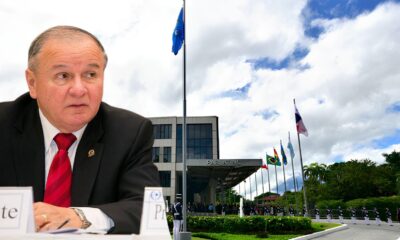Travel
Airspace closures, staff shortages and ageing tech: What’s behind 2023’s air traffic disruption?
2023 has been a disruptive year for air traffic control in Europe. Why is this, and will it continue into 2024?
We all appreciate the pilots who fly us safely to our destination. Some of us even clap for them on landing – much to the chagrin of fellow travellers.
But what about the hidden heroes guiding our safe path through the skies?
Air traffic control officers do the difficult job of keeping planes from crashing. Yet most of us had never even heard of them until they sparked travel chaos by going on strike this year.
When you know what it takes to become an officer, and the high stakes nature of their job, it’s easier to understand their demands for good working conditions and pay.
So what exactly is air traffic control, how do you get a career in it, and why has it been linked to so much travel disruption over the past year?
To find out what’s really behind Europe’s air traffic control problems and what it will take to fix them, Euronews Travel spoke to industry bodies, union members and the European Commission.
What it takes to become an air traffic controller
Staff shortages drove much of this year’s airport disruption and strike action.
The pandemic is partly to blame. The financial strain, health restrictions, low air traffic and uncertainty it caused put training for many air traffic controllers on hold. Being able to manage lots of overlapping planes is a key part of the job – and that takes practise.
“Adequate on-the-job training was only possible again when traffic levels had increased sufficiently to create a challenging practice environment,” explains Johnny Pring, the manager of Europe policy and advocacy at CANSO (the Civil Air Navigation Services Organisation), a representative body of air traffic control providers.
It takes at least 2.5 years to train an air traffic control officer (ATCO).
Every controller goes through basic training, followed by specialised training in a specific expertise, such as Tower Control, Approach Surveillance or Area Control Surveillance. They must then progress to field training at the airfield they will eventually control.
Finally, they will complete on-the-job training with an ATCO who is qualified to provide it. At airports where traffic has seasonal peaks, simulators are used for training during less busy periods to help maintain competence.
As every airport varies in density and complexity, and part of the training is location specific, air traffic controllers cannot be easily transferred between different airports.
At Maastricht Airport’s Upper Area Control Centre (MUAC) in the Netherlands – one of the most complex and busiest in Europe – the training takes approximately three years, according to Eurocontrol, an international organisation that works to achieve safe and efficient air traffic management across Europe.
Strict regulations govern the whole process and mean that most parts of the training can only be led by qualified ATCs. This means there is limited capacity for training, and staff shortages squeeze this even further.
What is air traffic control, anyway?
Air traffic control helps aircraft to move safely and efficiently through the sky.
Controllers are in constant contact with pilots, giving them information and advice to make sure they take off and land safely and on time. They give the pilots permission to take off, approve the route they’ll take, and ensure that aircraft are kept a safe distance apart in the skies, tracking their progress as they go.
In the UK, aircraft in the airways system are handled by NATS (National Air Traffic Services) and overseen by the Civil Aviation Authority (CAA). Eurocontrol oversees air traffic management across the European Union.
Various Air Navigation Service Providers (ANSPs) – the employers of controllers – provide individual air traffic control at airports, which is specialised to each location. Controllers hand over to one another as an aircraft travels between different jurisdictions.
What’s behind the ATC strikes and why are some more disruptive than others?
From strikes to technical failures, it’s been a turbulent year for Europe’s air traffic controllers.
In spring, French air traffic controllers (ATCs) began a strike in solidarity against pension reforms. Then in September, London’s Gatwick Airport was forced to limit flights after its already depleted ATC team was struck with COVID-19.
At the time, easyJet chief executive Johan Lundgren blamed understaffing for the disruption, telling a British newspaper that the way the service is structured, run and regulated is in need of modernisation.
The problems show no sign of abating. Just last weekend, passengers at London’s Heathrow Airport faced delays and cancellations due to ATC staff shortages and strong winds. On the same day in France, ATC staff staged a walkout that lasted until Tuesday and led to further disruption for travellers.
So what’s with all the air traffic control strikes?
Why are air traffic controllers going on strike?
Firstly, the cost of living crisis has led workers in various sectors to strike over pay. Many ATC strikes have been called to demand wages that are in line with inflation.
Unions have also called for improved working conditions and support for providing a safe and efficient service for transport users – especially in light of persistent staff shortages.
Most recently, French ATCs have walked out over new legislation requiring them to register their intent to strike at least 48 hours in advance.
Tuesday’s action in France marked the 65th day of strikes by air traffic controllers since the start of the year.
French strikes are particularly disruptive as they also affect ‘overflights’ using French airspace.
“Countries have different approaches to how ATC strikes are regulated,” explains CANSO’s Pring.
“In certain countries (Italy, Greece and Spain), overflights are protected and the strikes only affect domestic traffic; in others, all flights are affected. This regulation is a matter for national governments.”
How is the pandemic still affecting Europe’s air traffic controllers?
The pandemic is beginning to feel like a distant memory. Flights in Europe are back to over 94 per cent of 2019 levels and tourism is booming. But for air traffic controllers, its legacy lives on.
ANSPs manage air traffic on behalf of companies or countries, and collect fees from airspace users. With flights grounded during COVID-19, their revenue plummeted. This forced many of them to make cost savings, such as cutting staff.
ANSPs operating under the Single European Sky (SES) – an EU initiative that seeks to improve their performance – are faced with further cost pressures. The SES sets targets for safety, environment, capacity and cost-efficiency.
While its 2023 assessment shows that Europe’s ANSPs met their cost-efficiency targets, it highlights that “for some Member States, achieving this was a result of not adequately investing in their post-pandemic capacity” – with knock-on effects for capacity targets. It is possible that this was a conscious choice to help cut costs in line with targets.
However, this is not the aim of the legislation.
Why are ANSPs so heavily regulated?
As IATA – the trade association for the world’s airlines – explains, “Airports and air navigation services providers (ANSPs) are, for the most part, natural monopolies.” This means strong regulation is needed to ensure they do not raise their prices arbitrarily. It also aims to ensure they improve their services and maintain efficiency.
“In effect, the aim of the Single European Sky framework is to encourage monopolies to make the necessary investments with a view to being able to provide sufficient capacity and meet their performance targets,” explains Deborah Almerge Rückert, press officer for Transport and Mobility at the European Commission.
“Such investments could include training and hiring of staff, upgrading to newer systems, rollout of new technologies, radars and so on.”
All stakeholders, including ANSPs, airlines and professional staff organisations, are consulted when setting the performance targets, she adds, with differing views being taken into account.
In the UK, the Civil Aviation Authority (CAA) regulates air traffic control. It has recently approved a hike in prices to enable the provider to recover the costs lost during COVID-19. This will see the average cost of UK air traffic services rise by around £0.43 (€0.49) to around £2.08 (€2.39) per passenger per flight by 2027.
With air traffic now increasing, ANSPs are under pressure to hire more staff. However, since they are prevented from making a profit under rules established by the United Nations’ International Civil Aviation Organization (ICAO), more work doesn’t mean higher profits.
Why do ANSPs struggle with recruitment?
ANSPs have found it difficult to recruit new ATCOs – a challenge being faced by the whole aviation industry, according to Pring. This partly stems from air traffic control being a very niche industry that lacks access to top talent.
As most ANSPs are civil service organisations, their staff have certain job security rights and tend to work until retirement – which is capped at age 60 in many European countries due to the high-pressure nature of the roles.
As the demand for air traffic control really took off in the 1980s, many of the industry’s experts are now coming to the end of their careers.
“Looking ahead, many ANSPs will have to address a retirement wave over the next decade,” adds Pring, which could worsen the situation significantly if action isn’t taken soon.
Currently, slow or non-replacement of ATCOs after retirement is common practice due to budget limitations.
How has the war in Ukraine impacted air traffic control?
Still reeling from the pandemic, ANSPs were hit with a new unknown: Russia’s invasion of Ukraine in February 2022.
“[This] has led to unprecedented [air] traffic volatility across Europe,” says Pring.
As a result ANSPs face uncertainty in long and short term planning. They have also encountered fresh challenges, as ATCs have to adapt to new traffic flows due to airspace closures resulting from the war.
The route extensions resulting from the closure of Ukrainian, Belarussian and Russian airspace to European traffic have also pushed ANSPs off course in meeting their Single European Sky environmental targets.
Air traffic delays fell in 2023
All this is not to say that the safety of air travel has been compromised in any way. As Pring notes, “Throughout the pandemic and the recovery, the ATM [air traffic management] industry continued to deliver safe and efficient flight operations.”
He even points to some operational successes in summer 2023. Air traffic flow management delays per flight fell by 18 per cent from 2.7 minutes per flight to 2.3 minutes, compared to 2022, excluding weather factors.
During NATO’s major military air exercise carried out over Germany in June, ANSPs successfully managed to keep travellers flying with fewer disruptions than expected. Only 12,474 flights were directly delayed out of a total 293,928, or 4 per cent of all flights.
So how can ANSPs build on this positive momentum?
How can Europe fix its air traffic control problems?
Lundgren may have been on the money when he said that the way air traffic control is structured, run and regulated is in need of modernisation.
“Dealing with the forecast increase in air traffic and the increasingly complex traffic mix will require investment in technology – increased digitalisation or automation – and people,” says Pring. “So this is a major focus for European ANSPs.”
In France, improvements are already in the pipeline. The country has scheduled a major overhaul of its air traffic control system in 2024, with thousands of flights to be cut while it is installed.
The EU’s Single European Sky targets also have a role to play.
“In setting the targets for the coming years, it is crucial to strike the right balance between cost efficiency (which determines what ANSPs can charge their airline customers) and capacity and environment,” says Pring.
“Only in this way will ANSPs have sufficient financial means to invest in the necessary resources – staff and infrastructure – to service their customers.”
This is not the only role the European Commission plays in helping with reforms.
“The Commission is working with Member States to reform ATCO training, which is unnecessarily long and complex,” says Almerge Rückert.
It also aims to improve network management and system resilience by “allowing ATCO mobility across borders and/or cross-border service provision to fill capacity gaps,” she adds.
Such reforms to the Single European Sky would not only help to make service provision more efficient, flexible and scalable, but “should also help reduce flight cancellations in the event of strikes.”
Euronews Travel reached out to French union SNCTA, Belgium’s Union Syndicale Bruxelles (USB), and the UK’s GATCO and Prospect but did not hear back.
Travel
Venice 2024 review: ‘Babygirl’ – Nicole Kidman shines in sex-positive BDSM drama
Already the most talked about film in this year’s Competition, Nicole Kidman stars as a woman willing to risk it all for a torrid affair that allows her deepest desires to finally surface.
Romy (Nicole Kidman) has got it all. She is a successful and admired CEO with a doting husband Jacob (Antonio Banderas) and two teenage daughters (Esther McGregor and Vaughan Reilly).
That said, the fact that she heads up a company specialized in robotics and that her husband is a theatre director should tell you that she knows a thing or two about living life in automation mode and excels when it comes to nailing a performance when she needs to. As we learn in the first scenes of Babygirl, she is sexually going through the motions and needs to head to her laptop for some sub-dom roleplay once she’s had a seemingly intense orgasm with her husband.
She begins an affair with the cocksure Samuel (Harris Dickinson), one of her new interns who she previously clocked in the street taming a dog who was about to launch itself at her. She’s immediately drawn to his assertiveness, his disregard for office niceties and his general disobedient attitude. As their BDSM-tinged relationship develops, so do the threat levels.
Is Romy finally getting to explore the sexual terrains she has previously denied herself, putting her on the way to sexual fulfilment? Or is she being used by a rather predatory man who could torpedo her everything she has built at the drop of hat?
As Samuel casually points out: “I could make one call and you could lose everything.”
But that could be the biggest turn on of all… And she seems to realize it. When Jacob asks her early on if he is relevant to her as a director, she replies: “We are all irrelevant – we need to pay more attention to the avalanche that’s going to cover us very soon.”
Prescient words, as an avalanche is coming.
To label Babygirl a transgressive erotic drama might be doing it something of a disservice; while it is steamy at times, it’s more of a late-stage coming-of-age tale that deals with self-discovery and focuses on a woman’s vulnerability, shame, rage, and how she deals with slanted power dynamics.
Dutch director Halina Reijn, who previously directed Bodies Bodies Bodies, as well as Instinct, which centred on a psychosexual relationship between a sex offender and his therapist, shows once again that she can delve into illicit desires and gendered power dynamics with brio. Here, she shines not only in the way she explores how “shameful” desires need their space – and how their suppression can be just as potentially dangerous as a torrid affair – but also in her lack of moral judgement. Reijn’s film embraces the often-contradictory forces that make people who they are, and never judges its characters.
There are no good or bad binaries here; just complex people with voracious desires which adds to the central question: Who is in control?
Kidman excels when it comes to embodying this, and is mesmerizing throughout. She imbues Romy with an understated vulnerability and conveys her inner conflicts despite attempting to keep up appearances. As for Banderas, he delivers an understated performance that completely matches hers with significantly less screen time.
What prevents Babygirl from being a true knockout, however, are superior cinematic touchstones, as it’s hard (pipe down at the back) not to think of The Piano Teacher, Elle or Eyes Wide Shut. All feel relevant since (in order): Isabelle Huppert is this year’s jury president and starred in Michael Haneke’s erotic psychological drama; she also starred in the 2016 psycho-sexual thriller by Paul Verhoeven, a director who Reijn acted for in Black Book in 2006; and Kidman was on the Lido 25 years ago with the late director’s final – and controversial – film. Granted, all directed by men but feature complex female characters and explore layered feminine desire in ways that make behind-the-camera genders irrelevant.
Reijn’s take on the 80s erotic thriller remains a bold update, and never limits itself to post #MeToo moralising. It’s a brave film considering its candour and casting, as the film does hit at the heart of American puritanism and puts certain films that consider themselves to be envelope-pushing in perspective, highlighting once more that some of its supposedly taboo-shaking predecessors (9 ½ Weeks, Fifty Shades of Grey) are in fact tame in the extreme – and in the latter’s case, deeply insulting. However, the aforementioned films from Haneke, Verhoeven and Kubrick felt more challenging when exploring complicated and prudishly impermissible yearnings.
While Babygirl is an admirably sex-positive drama, it does tend to limit itself to: Honest and open communication regarding desire is vital. Crucial though that message is, the film may not be the electrifying, nor thought-provoking, jolt one could have hoped for.
Babygirl premiered at the 81st Venice Film Festival in Competition.
Travel
The best things to do and see (or watch) in Europe this week
Smelly da Vinci, drug cartel musical ‘Emilia Pérez’, ‘The Lord of the Rings: The Rings of Power’ and Nick Cave & the Bad Seeds’ ‘Wild God’ – here’s what to consume in Europe this weekend.
Ciao! Welcome back for another friendly roundup of things to do, watch and hear this weekend and beyond.
While our focus has very much been on the Paralympics and 81st Venice Film Festival beginning – and everyone else’s on the Oasis reunion – September’s tilt towards Autumn also brings a breeze of new art shows and cinema releases ahead of awards season, along with some fantastic local festivals and events.
From Renaissance smells to drug cartel musicals, we’ve narrowed things down to the following.
Exhibitions
‘Leonardo da Vinci and the Perfumes of the Renaissance’ at the Château du Clos Lucé (Amboise, France)
Leonardo da Vinci was known for being great at many things – but how many of you would name fragrance creation and collection among them? An exhibition in central France is highlighting this little-known fact about the 15th century Italian polymath, inviting guests to experience an “olfactory and immersive journey into the world of Renaissance perfumes, following the intertwined destinies of Leonardo da Vinci and his mother Caterina.”
It includes six sensory spaces, where visitors can sniff out what it might have been like to wander through the courts of Venice, Florence and Milan in the very times that Da Vinci himself once did. There are also over 60 of his reconstructed works of art and objects to on display, including the necklace from ‘Lady with an Ermine’. Unlike a lot of immersive exhibits, this is a truly multi-sensory event that’s cleverly constructed to uncover fascinating and previously unrecognised elements of Da Vinci’s works. It also highlights a growing trend in the use of scents at exhibitions to instigate a more intimate, revealing and inclusive encounter with art. See (and smell) it soon – closing on the 15 September 2024.
‘LAIKA: Frame x Frame’ at the BFI Southbank (London, UK)
For fans of Coraline and ParaNorman, the BFI’s new(ish – it opened 12 August) exhibition is a must. Dedicated to the award-winning stop-motion animation company LAIKA, who worked on the aforementioned films and others like Kubo and the Two Strings and The Boxtrolls, it showcases the armature-arousing intricacy of their creations and delves into the stories behind them. It’s also free – and being presented alongside a season celebrating stop motion animation in cinema. Just don’t leave with buttons for eyes.
Festivals and events
‘Jazz in the Park’ (Transylvania, Romania)
As if the fairytale-esque setting of Transylvania’s Ethnographic Park couldn’t be any more magical, it will be host to an annual jazz festival from 30-1 September. Limited to 7,000 people per day, it’s very much a community event that sees nearly every local getting involved and the entire village becoming a glowing hub of creativity and support. In 2019, it even won the title of Europe’s Best Small Festival at the European Festival Awards. This year, there will be 40 concerts across four stages, along with six delicious restaurants to try, workshops to take part in and much more. Find tickets here.
‘ALL CAPS’ (Rotterdam, Netherlands)
Paint the town red! And blue, and green, and all the colours because one of the world’s biggest street art festivals returns from 1 September to 8 September in Rotterdam’s Beverwaard district. Running for the past six years, the event sees everything from walls to cars painted with murals by incredible international artists, the neighbourhood transformed by an explosion of creativity and character. There will be music and food too, plus entry is free!
Movies
Public service announcement: UK-based readers – a reminder that it’s National Cinema Day on 31 August. The initiative, which was started by Cinema First, the Film Distributors’ Association and the UK Cinema Association in the wake of the Covid-19 pandemic to encourage people back to the big screen, it sees over 630 cinemas across the country selling tickets for just £4. In other words, there was never a better time or excuse to cancel all pre-existing plans and watch movies all day.
Emilia Pérez
A Spanish-language melodrama/musical about a Mexican cartel boss called Manitas (Karla Sofía Gascón) that wants to become a woman, it’s hard to imagine how such an audacious idea could actually work. But it does, with French director Jacques Audiard delivering “a bold and brilliant swing for the fences, a perfectly orchestrated folly with a fully realised vision that never plays it safe,” according to Euronews Culture’s David Mouriquand, who reviewed the film following its premiere at Cannes this year where Gascón and the principle female cast shared the best actress prize. The cast also includes Selena Gomez as Manitas’ wife, and Zoé Saldaña as the lawyer he kidnaps and tasks with finding a doctor to perform the desired surgical procedures.
Venice Film Festival 2024
The 81st Venice Film Festival is officially underway, having opened with Tim Burton’s Beetlejuice Beetlejuice on the 28 August (read the review for that one here). Known as the awards season whisperer, its line-up is richly varied (and a little bit steamy), with some of the most anticipated movies both inside and outside of Competition, including Pedro Almodóvar’s The Room Next Door, Todd Phillips’ Joker: Folie à Deux, Luca Guadagnino’s Queer and Athina Rachel Tsangari’s period drama Harvest. Stay tuned to Euronews Culture for all reviews and news updates from the Lido – including our latest review for Pablo Larraín’s Maria Callas biopic, starring Angelina Jolie.
TV show
The Lord of the Rings: The Rings of Power (Prime Video)
It was, quite possibly, Amazon’s biggest ever gamble: the first season of ‘The Lord of the Rings: The Rings of Power’, which premiered in 2022, had a budget of $1 billion (roughly €898,425 million) making it the most expensive TV show ever made. Did it pay off? Well, viewership was high and reviews generally positive, with Euronews Culture’s Giulia Carbonaro writing, “it manages to recreate an entire world – universe, if you like – of epic proportions that feels realistic and lived-in” but also noting, ” it falls into the trap of giving us what we already know and love, instead of bringing something truly original to the table.”
Now, after a long interlude, the second season has arrived and continues to unfurl the events of the fabled Second Age of J.R.R. Tolkien’s Middle-earth. While not all those who wander are lost, this show does have a tendency to dilly-dally in its own spectacle – we’re hoping it leads to some more eventful storylines this time around, especially considering the wait time!
Music
Nick Cave & the Bad Seeds: Wild God
It’s been a good year for Nick Cave & the Bad Seeds fans, with a TV adaptation in the works for Cave’s book “The Death Of Bunny Monro”, three major album anniversaries to celebrate, and now – finally – the release of the band’s 18th studio album ‘Wild God’.
“It’s a complicated record, but it’s also deeply and joyously infectious,” Cave said in a statement, adding: “There’s no fucking around with this record. When it hits, it hits. It lifts you. It moves you. I love that about it.” The album follows 2019’s ‘Ghosteen’ and shows, once again, the Seeds’ remarkable ability to continuously evolve their sounds in ever more interesting and deeply prophetic ways, while still touching on idiosyncratic familiarities. Read our full review here.
Travel
‘Nobody wants to see excessive queues’: How the UK is preparing for the EES launch in November
Every port, airport and land border has to install new technology before the Entry/Exit System launch on 10 November.
Travellers from outside the EU are getting ready for the launch of the new Entry/Exit System (EES) on 10 November, but are Schengen countries ready to welcome them?
There’s been much trepidation about Europe’s new digital border system, which has been repeatedly delayed.
But, finally, new scanners are appearing at airports across the EU and processing areas have been set up at international ports and train stations.
Millions of euros have been ploughed into preparing for the new checks, which will register non-EU passengers’ biometric data each time they enter and exit the Schengen Area.
Still, tourists have been warned of potential delays and queues at checkpoints when the EES launches this autumn.
What is the UK doing to prepare for the EES?
The changes will arguably hit post-Brexit Britain the hardest, with travellers forced to jump through new hoops when visiting the EU.
While airport checks will be carried out on arrival in EU countries, those for international train, car and ferry services will take place before departure from the UK.
The UK government is working hard to reduce queueing and disruption. This week, it announced £10.5 million (€12.5m) in funding to support preparations at the Port of Dover, Folkestone’s Eurotunnel and Eurostar at St Pancras train station in London.
This money is being used to set up the technology and processes needed for smooth EES registration, including establishing a dedicated processing site at the Port of Dover and installing additional self-service kiosks for Eurotunnel and Eurostar passengers.
At these kiosks, UK travellers will have to register at the border by having their fingerprints and photographs taken.
The funding will also be used to “undertake rigorous testing to reduce the risk of disruption”, according to the UK government, and support recruitment and training of staff to contribute to smoother EES implementation.
‘Nobody wants to see excessive queues’
Ministers in the UK say the funding will help minimise disruption for British travellers and ensure EES registration gets off to a smooth start.
“Nobody wants to see excessive queues at our ports, which is why we’re providing this funding to ensure our borders are as prepared as possible for the upcoming change – despite EES being an EU initiative,” says UK Future of Roads Minister Lilian Greenwood.
“Since coming into government, we have been reviewing plans and closely supporting ports to make sure they have the right processes in place so that EES registration can be smooth and queue times kept to a minimum.”
The government says the Port of Dover, Eurotunnel and Eurostar are “now on track for a smooth transition ahead of implementation later this year”.
Despite raising concerns earlier in the year, all three ports now offer a rosier picture of the EES implementation.
“Eurostar will be fully prepared and compliant by November, ensuring a smooth transition for all our passengers,” says Simon Lejeune, Eurostar chief safety and stations officer.
Yann Leriche, CEO of Getlink – which operates Eurotunnel – adds that thanks to two years of preparations and £70 million (€83m) in investments, “when the new regulation is introduced, people will travel through the Channel Tunnel just as easily as they do today.”
While it has been touch and go for some countries like Malta, which until July was expected to implement an alternative manual system after failing to start EES preparations early enough, the European Commission now insists all Member States are ready for the changes.
“At every single airport, every single harbour and every single road into Europe, we will have digital border controls – all connected, all switched on at the very same time,” European Commissioner for Home Affairs Ylva Johansson said on 16 August.
Despite these preparations, UK travel agents remain dubious about the EES launch.
A lack of awareness among travellers and varied levels of preparedness at different airports could cause “long queues, chaos and confusion”, travel association AITO has warned.
It has called for an extended transition period and for checks to be relaxed when waiting times are lengthy.
However, the European Commission confirmed to Euronews Travel in July that “all travellers subject to EES will be recorded in the system at all border crossing points from day one,” adding that it has provided all EU Member States with the “necessary tools to ensure a smooth traffic flow”.
A mobile app allowing passengers to pre-register their data before travelling will be available in some countries, but this is being adopted on a voluntary basis.
Concerns have also been raised about the EES launch clashing with the phase-in of the UK’s own Electronic Travel Authorisation (ETA) for visa-free travellers, which began in May.
The introduction of the ETIAS travel system in the first half of 2025, which will require non-EU visa-free travellers to obtain a €7 electronic travel authorisation, is expected to complicate travel even further.
-

 Sports6 days ago
Sports6 days agoInter on autopilot, everything easy with Lecce
-

 Health & Society5 days ago
Health & Society5 days agoThe intoxicated society
-

 Politics6 days ago
Politics6 days agoElias Castillo: A Stalwart of Latin American Legislative Leadership
-

 Sports6 days ago
Sports6 days agoGenoa passes in Monza with Pinamonti
-

 Sports5 days ago
Sports5 days agoOfficial: Juventus announces sixth purchase
-

 Sports4 days ago
Sports4 days agoBeautiful Juve: Vlahovic and youth rout Verona. Thiago Motta first
-

 Sports4 days ago
Sports4 days agoJuventus, Vlahovic: “Now we play a different game.”
-

 Sports6 days ago
Sports6 days agoFilippo Inzaghi enjoys his Pisa









